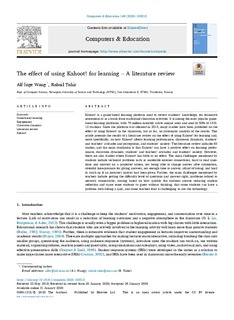| dc.description.abstract | Kahoot! is a game-based learning platform used to review students' knowledge, for formative assessment or as a break from traditional classroom activities. It is among the most popular game-based learning platforms, with 70 million monthly active unique users and used by 50% of US K-12 students. Since the platform was released in 2013, many studies have been published on the effect of using Kahoot! in the classroom, but so far, no systematic analysis of the results. This article presents the results of a literature review on the effect of using Kahoot! for learning and, more specifically, on how Kahoot! affects learning performance, classroom dynamics, students' and teachers' attitudes and perceptions, and students' anxiety. The literature review includes 93 studies, and the main conclusion is that Kahoot! can have a positive effect on learning performance, classroom dynamics, students' and teachers' attitudes, and students’ anxiety. However, there are also studies where Kahoot! has little or no effect. The main challenges mentioned by students include technical problems such as unreliable internet connections, hard to read questions and answers on a projected screen, not being able to change answer after submission, stressful time-pressure for giving answers, not enough time to answer, afraid of losing, and hard to catch up if an incorrect answer had been given. Further, the main challenges mentioned by teachers include getting the difficulty level of questions and answers right, problems related to network connectivity, scoring based on how quickly the students answer reducing student reflection and cause some students to guess without thinking, that some students can have a problem with failing a quiz, and some teachers find it challenging to use the technology. | nb_NO |

